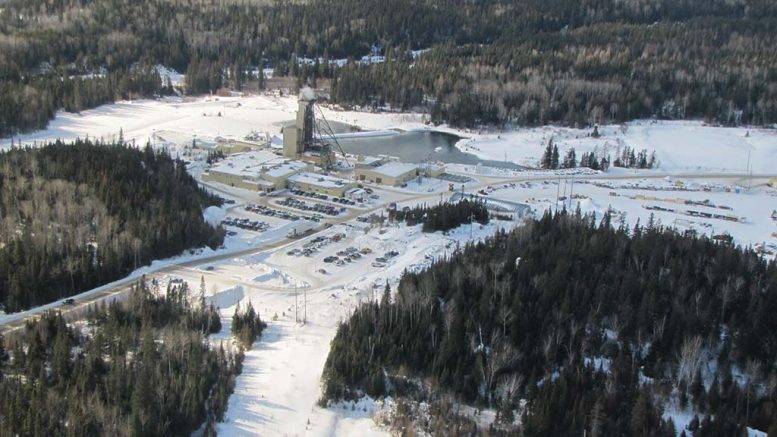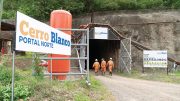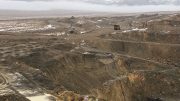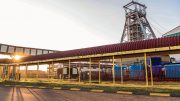Gold exploration and mine development remain leading drivers of mining activity around the world by Canadian-based gold companies. Here is a look at eight companies with significant developments in 2020.
Balmoral Resources

A helicopter near Balmoral Resources’ Bug Lake and Martiniere West gold deposits, part of the larger Detour Trend project in central Quebec. Credit: Balmoral Mining.
Balmoral Resources (TSX: BAR) is exploring for gold along the Detour trend within the Abitibi greenstone belt. At 700 sq. km, its Detour Gold Trend project in Quebec feature the Martiniere gold and Grasset nickel deposits, the Area 51/52 gold system, and additional zones of high-grade gold mineralization identified along the district-scale property. Kirkland Lake Gold’s (TSX: KL) Detour gold mine and property is 11 km west of the company’s grounds with Balmoral holding 20 km of the Detour-Sunday Lake deformation zone.
In February, the company started drilling at the Fenelon project within the Detour trend, targeting extensions of the gold system at Area 51. The company’s holdings are to the east and west of Wallbridge Mining’s (TSX: WM) Fenelon property, host to the Area 51 gold system. Balmoral controls the southeastern and northwestern continuations of the Area 51 corridor and holds the prospective ground at the intersection of this corridor with the Sunday Lake deformation zone.
Results from the Ripley zone, within the Area 51 system and nearby the Sunday Lake deformation zone, released in December, included 6.1 metres of 1.77 grams gold per tonne and 2.4 metres of 1.93 grams gold per tonne. To the west, the Martiniere gold system features two gold deposits with additional near-surface discoveries.
The company’s Grasset nickel deposit is east of the Fenelon grounds and features indicated resources of 3.5 million tonnes at 1.79% nickel-equivalent for a total of 119 million lb. nickel with additional copper, cobalt and platinum group metals (PGMs). Inferred resources stand at 91,100 tonnes grading 1.19% nickel-equivalent for a total of 2.1 million lb. nickel. The deposit remains open.
Also in Quebec, Balmoral holds the Rum nickel project with 16 drill-ready targets.
The company plans to drill at least 20,000 metres this year at the Detour Gold Trend project.
Balmoral Resources has an $83.6-million market capitalization.
Eastmain Resources

Eastmain Resources’ Eau Claire gold project exploration camp in Quebec’s James Bay region. Credit: Eastmain Resources.
Eastmain Resources (TSX: ER) is developing the Clearwater and Eleonore South joint-venture projects in Quebec’s James Bay region.
Clearwater features the Eau Claire deposit as well as the Knight Serendipity (KS) horizon, host to a banded iron formation. A 2018 preliminary economic assessment (PEA) for Eau Claire outlined a combined open pit and underground operation with a 12-year mine life, producing an average of 86,100 oz. gold over the first 10 years at all-in sustaining costs of US$574 per oz. The pre-production capital estimate came in at $175 million with a $260-million net present value estimate, at a 5% discount rate. The majority of current resources are in the underground category.
Eastmain is currently working on a revised PEA for Eau Claire, which will be followed by permitting, bulk sample extraction and additional drilling.
In addition to Eau Claire, the Clearwater property is host to a 14-km long banded iron formation, which features the KS horizon, 14 km from the Eau Claire deposit. Targets along this unit include Percival and Caradoc with electromagnetic surveys identifying additional zones for follow-up.
Eau Claire features measured and indicated resources of 4.3 million tonnes grading 6.18 grams gold per tonne for a total of 853,000 oz. gold with additional inferred resources of 2.4 million tonnes at 6.53 grams gold per tonne totaling 500,000 ounces.
Eastmain is aiming for a total of 3 million oz. gold in all resource categories by next year at Clearwater, from expanding the Eau Claire deposit at depth and exploring along the KS horizon.
The company also holds a 36.7% interest in the Eleonore South joint-venture (36.7% Newmont (TSX: NGT; NYSE: NEM), 26.6% Azimut Exploration (TSXV: AZM)), located just south of Newmont’s Eleonore mine. The 147-sq.-km property features a 5-km long prospective trend.
Eastmain has a $27.5-million market capitalization.
Galway Metals

A moose near the dormant mill adjacent to Galway Metals’ Clarence Stream gold project in New Brunswick, 70 km from Fredericton. Credit: Galway Metals.
Galway Metals (TSXV: GWM) is a gold and zinc explorer focused on its projects in New Brunswick and Quebec.
The 605-sq.-km Clarence Stream project in New Brunswick, 70 km from Fredericton, encompasses a 65-km long prospective underexplored belt.
Current resources are contained in the North and South zones with open-pit measured and indicated resources of 5.9 million tonnes grading 1.85 grams gold per tonne for 352,200 oz. contained gold and additional inferred resources of 2.7 million tonnes grading 1.87 grams gold totaling 153,100 ounces. Underground indicated resources comprise 267,000 tonnes at 4.39 grams gold per tonne for 37,800 oz. gold with an additional inferred underground component of 862,000 tonnes grading 4.48 grams gold per tonne totaling 124,100 ounces.
Existing resources are contained within a 2.5-km section of the 65-km long project corridor. Additional targets along the trend include the Richard, Jubilee and George Murphy zones. In January, Galway released drill results from the Richard zone with intercepts including 29.7 metres of 4.6 grams gold per tonne and 4.8 metres of 20.9 grams gold per tonne. These three zones now cover 2.5 km of strike length with a resource update, as well as 25,000 metres of drilling, planned for Clarence Stream this year.
The past-producing Estrades project in Quebec covers 31 km of strike with three known mineralized trends. In the 1990s, a total of 175,000 tonnes were extracted at a head grade of 12.9% zinc, 6.4 grams gold per tonne, 1.1% copper and 172.3 grams silver per tonne from an underground access to the volcanogenic massive sulphide deposit. The material was trucked to the Matagami mill.
Current resources at Estrades stand at 1.5 million tonnes in the indicated category at 11.28 grams silver-equivalent for a total of 543,050 silver-equivalent oz. with additional inferred resources of 2.2 million tonnes at 7.36 grams silver-equivalent totaling 520,430 silver-equivalent ounces.
This year, Galway plans to drill 1,000 metres and complete geophysical surveys and ore sorting tests at Estrades.
Galway Metals features the management team that led the $340-million sale of Galway Resources to Eike Batista’s AUX in 2012.
Galway Metals has a $44.4-million market capitalization.
Great Bear Resources

A drill rig on Great Bear Resources’ Dixie Lake gold property in Red Lake, Ontario. Credit: Great Bear Resources.
Great Bear Resources (TSXV: GBR) wholly owns the 91-sq.-km Dixie gold project in Ontario’s Red Lake district. Dixie hosts two styles of mineralization — high-grade disseminated gold along the LP fault as well as high-grade gold in quartz veins and replacement zones.
The majority of Great Bear’s exploration efforts have been focused along the 18-km long stretch of the LP fault zone traversing the property. In February, the company announced that it has traced gold mineralization over a 4.2 km stretch of the fault. The company now plans to test a 5-km section of this 18-km structure down to a depth of 500 metres, to cover a 2.5 sq. km panel.
All of the 59 holes that Great Bear completed over the 4.2 km section of the LP fault intersected mineralization, which remains open on strike and at depth.
Recent drill highlights include 5.9 metres of 190.78 grams gold per tonne, 7 metres of 68.76 grams gold per tonne and 22.85 metres of 19.33 grams gold per tonne. The high-grade mineralization is also near-surface.
Up to 300 holes are planned for this year along the 5-km panel as part of Great Bear’s fully funded $21 million exploration program. Four rigs are currently drilling along the LP fault with a fifth rig mobilized for regional exploration, testing new targets at Dixie and stepping out along the prospective structure.
Great Bear initially acquired the Dixie project in 2015 and consolidated its interest to 100% in 2017.
In January, the company announced that it has entered into a 2% net smelter return royalty agreement with its wholly owned subsidiary; it plans to distribute shares in the royalty company to its shareholders in the coming months.
Great Bear has a $410.2-million market capitalization.
Kirkland Lake Gold

Kirkland Lake Gold’s Fosterville gold mine in Australia. Credit: Kirkland Lake Gold.
Kirkland Lake Gold (TSX: KL; NYSE: KL) is a gold producer with operations in Ontario and Australia.
In November, the company announced the $4.9-billion all-share acquisition of Detour Gold, adding the 60,000 tonne-per-day Detour Lake open-pit mine in northeastern Ontario to its portfolio. The transaction closed at the end of January.
This year, the company expects to produce 1.47 million oz. to 1.54 million oz. of gold from the Macassa, Detour Lake, Holt and Fosterville operations at all-in sustaining costs (AISCs) of US$820 to US$840 per ounce. Last year, Kirkland Lake generated 974,615 oz. at AISCs of US$564 per ounce.
In 2020, the low-cost, high-grade Fosterville underground operation in Australia is expected to contribute 590,000 oz. to 610,000 oz. at operating cash costs of US$130 to US$150 per ounce.
Guidance for Detour Lake is 520,000 oz. to 540,000 oz. at operating cash costs of US$720 to US$740 per oz., reflecting 11 months of production from the mine. As early as next year, Kirkland Lake expects this asset to produce over 700,000 oz. gold annually at AISCs of approximately US$850 per ounce.
The company’s flagship Macassa underground mine in Kirkland Lake, Ontario is forecast to generate 240,000 oz. to 250,000 oz. gold in 2020 at operating costs of US$470 to US$490 per ounce. The 1,000 tonne-per-day operation extracts ore from two mining horizons.
This year, Kirkland Lake Gold plans to spend US$150 to US$170 million on exploration with US$25 to US$30 million designated for drilling within and around the Detour Lake open pit as well as at a number of regional targets.
The company has announced a value enhancement program for 2020, planning to repurchase 20 million of its common shares, an estimated $750 million undertaking, as well as doubling its annual dividend to US$0.5 per share to return approximately $145 million to equity holders.
With the closing of the Detour Gold acquisition, the company designated the Holt complex in Ontario and its assets in Australia’s Northern Territory as non-core; Kirkland Lake is considering strategic options for these properties.
Kirkland Lake Gold has a $13.4-billion market capitalization.
Lumina Gold

The Cangrejos camp in southwest Ecuador. Credit: Lumina Gold.
Lumina Gold (TSXV: LUM) is a precious and base metals exploration and development company focused on its Cangrejos gold-copper project in southwest Ecuador. The project is 30 km southeast of the provincial capital of Machala and the Pan American Highway and 40 km from the deep water commercial port of Puerto Bolivar
The Cangrejos project is located in the Andean foothills of El Oro province, which has a long established history of mining. Lumina Gold, formerly Odin Mining, identified the Cangrejos area in 1994 as the source of the Biron alluvial gold deposit, which yielded 69,000 oz. gold. A joint venture was formed with Newmont Mining (NYSE: NEM) and from 1994 to 2001 geophysical and geochemical surveys were completed and anomalies were tested by diamond drilling. The Cangrejos zone was discovered by hole CC-99-14, which intersected 1.57 grams gold per tonne over 192 metres.
Today Lumina Gold owns 100% of the project, which currently consists of two deposits — Cangrejos and Gran Bestia. In November 2019, the company significantly updated its resource estimate for Cangrejos and unveiled a maiden resource estimate for Gran Bestia.
The Cangrejos deposit now contains 469 million tonnes of indicated resources grading 0.59 gram gold per tonne and 0.12% copper for 8.9 million oz. contained gold and 1.2 billion lb. copper. Inferred resources stand at 255 million tonnes grading 0.43 gram gold per tonne and 0.08% copper for 3.5 million oz. gold and 466 million lb copper. The Cangrejos deposit remains open to expansion with further exploration to the west and at depth.
Gran Bestia has indicated resources of 99 million tonnes grading 0.46 gram gold per tonne and 0.08% copper for 1.5 million oz. contained gold and 178 million lb. copper, and inferred resources of 221 million tonnes grading 0.39 gram gold per tonne and 0.07% copper for 2.7 million oz. contained gold and 322 million lb. copper. The Gran Bestia deposit remains open to the north, west and at depth.
In the latest set of drill results from Cangrejos, released in Sept. 2019, drillhole G2B returned one of the best mineralized intervals ever intercepted at Cangrejos with 444 metres averaging 1.18 grams gold per tonne and 0.09% copper from a depth of 4 metres.
The company plans to complete an updated preliminary economic assessment on the project in the second quarter of 2020 that will update the 2018 PEA and integrate the addition of a carbon-in-leach circuit and a high-pressure grinding rolls (HPGR).
Mining entrepreneur and financier Ross Beaty owns 19.9% of the company’s outstanding common shares.
Lumina Gold has a $255-million market cap.
Marathon Gold

The camp at Marathon Gold’s Valentine Lake gold project in Newfoundland. Credit: Marathon Gold.
Marathon Gold (TSX: MOZ) is developing the wholly-owned Valentine gold project in central Newfoundland. The project features four deposits along a 20-km long system of gold-bearing veins; Marathon and Leprechaun are the primary resource contributors.
In January, the company released updated resources for Valentine: measured and indicated resources are now at 54.9 million tonnes grading 1.75 grams gold per tonne for a total of 3.1 million oz. gold with additional inferred resources of 16.8 million tonnes of 1.78 grams gold per tonne for 960,000 ounces.
This resource features open pit and underground components with the surface mining material divided into high-grade and low-grade portions. The high-grade open-pit component features 30.6 million tonnes grading 2.62 grams gold per tonne in the measured and indicated category for a total of 2.6 million oz. gold, with a further 7.7 million tonnes at 2.31 grams gold per tonne totaling 570,000 inferred ounces.
A pre-feasibility study for the Valentine project is expected in the second quarter. The study will examine the option of a single ore stream from the Leprechaun and Marathon deposits feeding a conventional mill. The pre-feasibility will only consider in-pit resources with stockpiling of lower-grade material for processing in the later years of mine life.
Marathon expects to complete an environmental impact statement on the project this year.
A 2018 PEA for Valentine suggested a 9,000 tonne-per-day mill processing higher grade ore with lower grade material destined for a 9,000 tonne-per-day heap leach pad. The resulting project would produce an average of 225,100 oz. gold a year at AISCs of US$666 per oz. with an associated net present value estimate of US$493 million, at a 5% discount rate, and a pre-production capital outlay of US$355 million.
This year, Marathon is planning to drill 44,000 metres at Valentine, which will be focused on prospective areas outside of the current resource. Up to 32,000 metres are planned for the 6 km-long Sprite corridor between the Leprechaun and Marathon deposits.
Marathon Gold has a $268.2-million market capitalization.
Pure Gold Mining

A truck hauls ore from test mining at the Madsen gold project. Credit: Pure Gold Mining.
Pure Gold Mining (TSXV: PGM; LSE: PUR) is developing the Pure Gold Red Lake mine in northwestern Ontario. The mine sits within a 47-sq.-km property, host to two past-producing underground operations: Pure Gold Red Lake and Starratt, with total past production of 2.6 million ounces.
In February 2019, the company released the results of a feasibility study for the Pure Gold mine, which outlined an 800 tonne per day operation with a 12-year life producing an average of 80,000 oz. of gold a year at AISCs of US$787 per ounce. The initial capital was pegged at $95 million with the resulting net present value estimated at $247 million, at a 5% discount rate.
The associated probable reserves for the project stand at 3.5 million tonnes grading 9 grams gold per tonne for a total of 1 million oz. gold, within indicated resources of 7.2 million tonnes at 8.9 grams gold per tonne totaling 2.1 million ounces. Current resources are open for expansion and are within a 7-km long mineral system.
Mine construction is underway with first production expected towards the end of the year.
In January, the company released the results of drilling completed close to existing mine development, which intersected 2.2 metres of 34.1 grams gold per tonne and 3.4 metres of 33.1 grams gold per tonne. This work targeted ore zones that will make up the initial mill feed and suggests potential for stope expansion as well as definition of new mineralized zones.
Pure Gold has installed infrastructure at the mine with de-watering of the underground proceeding on schedule.
Pure Gold Mining has a $276-million market capitalization.






Be the first to comment on "Precious Metals Snapshot: Eight companies advancing projects globally"